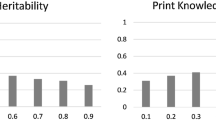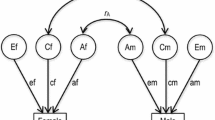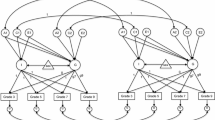Abstract
To test the hypothesis that the etiology of individual differences in reading performance differs in males and females, reading performance data from twin pairs tested in the Colorado Learning Disabilities Research Center were fitted to structural equation models of sex limitation. The sample included 513 pairs of twins in which at least one member of each pair has a positive school history of reading problems [228 monozygotic (MZ), 176 same-sex dizygotic (DZ), and 109 opposite-sex DZ pairs] and 302 matched control pairs [148 MZ, 98 same-sex DZ, and 56 opposite-sex DZ pairs]. Estimates of the genetic correlation between performance in males and females were obtained by analysis of data from both same-sex and opposite-sex twin pairs (Neale and Cardon, 1992). The full model fit the data well χ2=17,74, df=16,p=0.340), and the resulting genetic parameter estimates were highly similar in males and females in both the proband and the control samples. The correlations between genetic influences in males and females do not differ among groups (change in χ2=0.95, df=1,p≥0.25), and the resulting pooled estimate is about .5. Thus, results of this analysis suggest that the etiology of individual differences in reading performance may differ to some extent in males and females.
Similar content being viewed by others
References
Ackerman, P. T., and Dykman, R. A. (1993). Gender and rading disability.J. Learn. Disabil. 26:498.
DeFries, J. C., and Decker, S. N. (1982). Genetic aspects of reading disability: A family study. In: R. N. Malatesha and P. G. Aaron (eds),Reading Disorders: Varieties and Treatments, Academic Press, New York, pp. 255–279.
DeFries, J. C., and Fulker, D. W. (1985). Multiple regression analysis of twin data.Behav. Genet. 15:467–473.
DeFries, J. C., and Gillis, J. J. (1991). Etiology of reading deficits in learning disabilities: Quantitative genetic analysis. In: J. E. Obrzut and G. W. Hynd (eds.),Neuropsychological Foundations of Learning Disabilities: A Handbook of Issues, Methods and Practice, Academic Press, Orlando, FL, pp. 29–47.
DeFries, J. C., and Gillis, J. J. (1993). Genetics of reading disability. In R. Plomin and G. E. McClearn (eds.),Nature Nurture & Psychology, American Psychological Association, Washington, DC, pp. 121–145.
DeFries, J. C., Fulker, D. W., and LaBuda, M. C. (1987). Evidence for a genetic aetiology in reading disability of twins.Nature 329:537–539.
DeFries, J. C., Olson, R. K., Pennington, B. F., and Smith, S. D. (1991). Colorado reading project: Past, present, and future.Learn. Disabil. 2:37–46.
DeFries, J. C., Gillis, J. J., and Wadsworth, S. J. (1993). Genes and genders: A twin study of reading disability. In A. M. Galaburda (ed.),Dyslexia and Development. Neurobiological Aspects of Extra-Ordinary Brains Harvard University Press, Cambridge, MA, pp. 187–204.
Dunn, L. M., and Markwardt, F. C. (1970).Examiner's Manual: Peabody Individual Achievement Test, American Guidance Service, Circle Pines, MN.
Eaves, L. J., Last, K., Young, P., and Martin, N. G. (1978). Model-fitting approaches to the analysis of human behaviour.Heredity 41:249–320.
Finucci, J. M., and Childs, B. (1981). Are there really more dyslexis boys than girls? In A. Ansara, N. Geschwind, A. M. Galaburda, M. Albert, and N. Gartrell (eds.).Sex Differences in Dyslexia, Orton Dyslexia Society, Towson, MD, pp. 1–10.
Fulker, D. W., Cardon, L. R., DeFries, J. C., Kimberling, W. J., Pennington, B. F., and Smith, S. D. (1991). Multiple regression analysis of sib-pair data on reading to detect quantitative trait loci.Read. Writing Interdisc J. 3:299–331.
Geschwind, N. (1981). A reaction to the conference on sex differences and dyslexia. In A. Ansara, N. Geschwind, A. M. Galaburda, M. Albert, and N. Gartrell (eds.),Sex Differences in Dyslexia, Orton Dyslexia Society, Towson, MD, pp. xiii-xviii.
Geschwind, N., and Behan, P. (1982). Left-handedness: Association with immune disease, migraine, and developmental learning disorder.Proc. Natl. Acad. Sci. 79:5097–5100.
Geschwind, N., and Galaburda, A. M. (1985). Cerebral lateralization: Biological mechanisms, associations, and pathology (parts i, ii, and iii).Arch. Neurol. 42:428–654.
Gillis, J. J., and DeFries, J. C. (1989). Validity of school history as a diagnostic criterion for reading disability.Read. Writ. Interdisc. J. 2:93–101.
James, W. H. (1992). The sex ratios of dyslexic children and their sibs.Dev. Med. Child Neurol. 34:530–533.
Lubs, H. A., Rabin, M., Feldman, E., Kushch, A., Gross-Glenn, K., Duara, R., and Elston, R. C. (1993). Familial dyslexia: Genetic and medical findings in eleven three-generation families.Ann. Dyslex. 43:44–60.
Martin, N. G., and Wilson, S. R. (1982). Bias in the estimation of heritability from truncated samples of twins.Behav. Genet. 12:467–472.
Neale, M. C. (1991).Mx: Statistical Modeling, Department of Human Genetics, Box 3, MCV, Richmond, VA 23298.
Neale, M. C., and Cardon, L. R. (1992).Methodology for Genetic Studies of Twins and Families Kluwer Academic, Dordrech, The Netherlands.
Neale, M. C., and Martin, N. G. (1989). The effects of age, sex, and genotype on self-report drukenness following a challenge dose of alcohol.Behav. Genet.,19:63–78.
Nichols, R. C., and Bilbro, W. C. (1966). The diagnosis of twin zygosity.Acta Genet. Stat. Med. 16:265–275.
Petrill, S. A., and Thompson, L. A. (1994). The effect of gender upon heritability and common environmental estimates in measures of scholastic achievement.Personal. Indiv. Diff. 16:631–640.
Plomin, R., DeFries, J. C., and McClearn, G. E. (1990).Behavioral Genetics: A Primer. Freeman, New York.
Shaywitz, S. E., Shaywitz, B. A., Fletcher, J. M., and Escobar, M. D. (1990). Prevalence of reading disability in boys and girls.JAMA 264:998–1002.
Smith, S. D., Pennington, B. F., and Lubs, H. A. (1983). Specific reading disability: Identification of an inherited form through linkage analysis.Science 219:1345–1347.
Smith, S. D., Kimberling, W. J., and Pennington, B. F. (1991). Screening for multiple genes influencing dyslexia.Read. Writ. Interdisc. J. 3:285–298.
Stevenson, J. (1992). Identifying sex differences in reading disability: Lessons from a twin study.Read. Writ. Interdisc. J. 4:307–326.
Symmes, J. S., and Rapoport, J. L. (1972). Unexpected reading failure.Am. J. Orthopsychiat. 42:82–91.
Tallal, P., and Fitch R. H. (1993). Hormones and cerebral organization: Implications for the development and transmission of language and learning disabilities. In A. M. Galaburda (ed.),Dyslexia and Development. Neurobiological Aspects of Extra-Ordinary Brains, Harvard University Press, Camrbidge, MA, pp. 168–186.
Tallal, P., Ross, R., and Curtiss, S. (1989). Unexpected sexratios in families of language/learning-impaired children.Neuropsychologia 27:987–998.
Vogel, S. (1990). Gender differences in intelligence, language, visual-motor abilities, and academic achievement in students with learning disabilities: A review of the literature.J. Learn Disabil. 23:44–52.
Wadsworth, S. J., DeFries, J. C., Stevenson, J., Gilger, J. W., and Pennington, B. F. (1992). Gender ratios among reading-disabled children and their siblings as a function of parental impairment.J. Child Psychol. Psychiat. 33:1229–1239.
Wechsler, D. (1974).Examiner's Manual: Wechsler Intelligence Scale for Children—Revised, The Psychological Corporation, New York.
Wechsler, D. (1981).Examiner's Manual: Wechsler Adult Intelligence Scale—Revised, The Psychological Corporation, New York.
Author information
Authors and Affiliations
Rights and permissions
About this article
Cite this article
Alarcón, M., DeFries, J.C. & Fulker, D.W. Etiology of individual differences in reading performance: A test of sex limitation. Behav Genet 25, 17–23 (1995). https://doi.org/10.1007/BF02197238
Received:
Accepted:
Issue Date:
DOI: https://doi.org/10.1007/BF02197238




